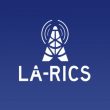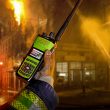InfraLynx Hummer delivers interoperability on wheels
The U.S. Naval Research Laboratory in Washington has out-fitted a high-mobility, multipurpose, wheeled vehicle (HMMWV, pronounced “Humvee” or “Hummer”) with almost every telecommunications link a public safety agency might need. Interoperable radio communications from 2 MHz to 800 MHz; private cellular and landline telephone networks; even microwave and two-way satellite communications for voice, data, and video are included in the sleek black truck dubbed InfraLynx.
“Our goal was to devise a unit that could roll into a ‘hot zone’ and immediately provide first responders with the connectivity they need,” said Chris Herndon, head of NRL’s Tactical Technologies Development Lab, which developed the InfraLynx. “In particular, now that first responders are faced with the possibility of coordinated terror attacks, we wanted to make sure that they can talk easily with each other and the outside world.”
Before Sept. 11, 2001, the lab was developing modular communications systems for the military, using standardized RF components that work in all kinds of vehicles, rather than doing custom-installs for each application.
“A few days after [the terrorist attack], we were asked if we could combine some of our modular units into a radio recovery vehicle for New York,” Herndon said. “Within 24 hours, we had tailored a Hummer for military-style operations at Ground Zero.”
This radio recovery vehicle became the blueprint for the InfraLynx.
Equipped with a rigid shelter with a roof-mounted 1.5m satellite dish, the InfraLynx is fitted with a JPS Communications ACU-1000 modular interconnect system. You can plug as many as 10 two-way radios or handsets into the computer-controlled cross-connect, but the correct radios must be on hand to let the ACU interconnect the required communications.
“We have a complete suite of 24 radios, from Ericsson to Motorola, in the InfraLynx. And we have some of the new software-programmable radios that are under development. These units can simply be reprogrammed to emulate whatever modulation and bandwidth you need,” said Herndon.
With its 1.5 m satellite antenna, the InfraLynx can connect as many as 96 landline telephones. The demand for communications when the New York World Trade Center’s twin towers caught fire and col-lapsed along with other buildings proved that an alternative connection to landlines matters.
“What first tied up cellular communications in New York wasn’t that the airwaves were jammed, but rather that Verizon’s WTC trunking vault was destroyed. Using the InfraLynx, we can ‘reconnect’ landlines to the outside world in a few minutes,” Herndon said.
When cellular communications were restored in New York on Sept. 11, they were jammed by frantic callers. InfraLynx is equipped to provide 24 channels of private cellular communications that the public can’t access, keeping them open for first responders.
InfraLynx also supports data and fax communications, and can patch hand-held two-way radios directly into the telephone system. Its satellite dish can uplink video, so headquarters staff can watch what’s happening. InfraLynx also can download video to allow officials to speak directly to rescuers.
With large diesel tanks, “the InfraLynx can run for up to four days without refuelling,” said Herndon.
As first responders in New York learned, having enough fuel to keep running proved to be a challenge.
Money for interoperability
In the wake of Sept. 11, NRL received enough money from the Navy’s Counter Terrorism Technology Task Force to build two InfraLynx trucks. Today, they’re travelling around the country, showing their capabilities to public safety managers and politicians.
NRL has estimated that turn-key Infralynxes could be built for $800,000 each. Initially, it appeared as though the Department Defense would buy six more for placement in several large cities. But it appears as though the Department of Defense is waiting to see what the proposed Department of Homeland Security might do with this technology.
In the meantime, Herndon and the NRL are focusing on public safety’s grass roots.
“We’re trying to get local communities interested in the InfraLynx, and what it can do for them,” Herndon said. “That’s why we’re staging exercises and demos, to get local officials thinking, and hopefully to motivate them to put an InfraLynx into next year’s budget plans.”
Washington may eventually help with funding. But some cities aren’t waiting. Chicago’s Office of Emergency Communications intends to budget for an InfraLynx.
“We also have inter-agency agreements with the Office of Domestic Preparedness, the National Institute of Justice, and the Washington, D.C., Emergency Management Agency,” Herndon said.
“In an effort to keep costs down, we’ve used as much off-the-shelf equipment as possible. And we’re interested in licensing the technology to the private sector, so that vendors can start building the InfraLynx commercially. Given that this vehicle contains such a wide range of equipment, we don’t expect any one company to be able to do the job. That’s why we’re looking at forming partnerships with companies in the private sector,” Herndon said.
For more information on the Infralynx, visit www.infralynx.com or www.nrl.navy.mil.
Careless is a freelance telecommunications writer based in Ottawa, Ontario, Canada. His e-mail address is [email protected].
InfraLynx’s capabilities
- Ku/Ka SATCOM
- Provides bi-directional networking — 9.6Mbps (Full Duplex)
- ATM transport stream supports multiple simultaneous protocols for telephony, IP, MPEG video and VTC
- Multiple independent levels of security (MILS) multiplexed on single broadcast
- Classified/Unclass Networks on single transport stream
- KG-175 TACLANE functionality
- Land mobile radios
- Frequency coverage — HF, VHF lowband, VHF highband, UHF and 800 MHz
- All frequencies can be cross-banded to others for interoperability
- All frequencies can be linked to telephone lines to allow handheld radios to place calls over SATCOM
- All frequencies converted to VOIP (H.323) to allow remote communications to NetMeeting or other VOIP interfaces
- User in one location on 800 MHz radio can talk to another user in another location on 450MHz radio over satellite/Internet
- Private Cellular Network
- Provides private network independent of existing cellular providers
- Bridged to LMR and SATCOM
- Type 1 encrypted cell phone compatible with STU3
- Telephony Services
- Capacity for 96 additional POTS lines, configured for 24
- Supports phone, fax, STU3, dial in/out modems
- Linked to all communications equipment
- Streaming Video
- Local video streamed via SATCOM or terrestrial links to remote users
- Web browser interface
- Cameras on vehicles give remote users views “of the incident”
- Local and satellite television can be streamed to remote users
- Multiple Computing Platforms Support a Wide Variety of Applications
- On board systems configured with Windows 2000 and Linux
- PCs can be replaced with Sparc Ultras as needed
- Remote Capability
- All capabilities can be remotely accessed from vehicle (wired or wireless)

















